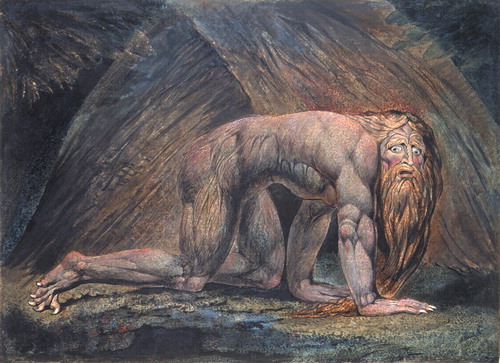William Blake (1757–1827)
William Blake was both a great poet and a great painter. Blake invented a method of relief engraving that was able to combine his poetry and paintings so that they formed a unified work. In the West, only Michelangelo had previously demonstrated such singular talent in both painting and poetry, but unlike Blake he did not combine them. Blake was one of the progenitors of the revolutionary Romantic movement, and his verse was admired by Coleridge and Wordsworth.
Stanzas by Blake such as the following have become an imperishable part of the Western canon:
To see a World in a Grain of Sand
And a Heaven in a Wild Flower
Hold Infinity in the palm of your hand
And Eternity in an hour
— from “Auguries of Innocence”
Long before Heinz Kohut and self psychology, Blake captured the essential tragedy of narcissistic pathology:
Love seeketh only Self to please,
To bind another to its delight,
Joys in another’s loss of ease,
And builds a Hell in Heaven’s despite
— from “The Clod and the Pebble”
Blake’s father owned a hosiery and haberdashery shop in London. As was common for tradesmen, the family lived above the shop. Blake was the third child of six. He was raised in the Protestant Dissenting tradition, one that emphasized private devotion and individual conscience separate from the authority of priest and church. In the lexicon of the 18th century, the term for extreme dissent was “enthusiasm” (possessed by God). Later in life, Blake, who was deeply religious, referred to himself as an “enthusiastic hope-fostered visionary.” He demonstrated artistic and literary talent from an early age, and his enlightened parents enrolled him in a drawing school at the age of 10. He was educated as a commercial engraver and was later admitted as a student to the prestigious Royal Academy. In 1782, Blake married a woman from a working-class family. This was a childless but mutually devoted marriage that lasted 45 years. Blake’s artistic career underwent many financial vicissitudes, and though he had a number of aristocratic patrons who recognized his originality, his true genius was not fully appreciated until after his death. He may have died from liver failure secondary to biliary cirrhosis induced by chronic copper ingestion during his etching copper plates for his engravings.
From his childhood onward Blake saw visions. His biographer, Bentley, recounts, “Once his mother beat him for running in and saying that he saw the prophet Ezekial under a Tree in the Field” (1, p. 19) and, “Later when he was eight or ten, one day as he was walking—he saw a tree filled with angels, bright angelic wings bespangling every bough like stars” (p. 19). His wife commented in 1810, “I have very little of Mr. Blake’s company; he is always in Paradise.” Blake’s recurrent hallucinatory visions suffused his poetry and painting, especially his great epics and their accompanying watercolors and engravings.
Alongside his ecstatic visions, Blake was prone to fits of severe depression. In 1800, he recounted a descent into “a Deep pit of Melancholy, Melancholy without any real reason for it.” These episodes were often followed by periods of “illumination” and intense creativity. This is highly suggestive of bipolar illness, albeit a mild form that did not disrupt his enormous creative achievement and may have been central to his transcendent artistic vision.
Address correspondence and reprint requests to Dr. Buckley, 336 Central Park West #5A, New York, NY 10025; [email protected] (e-mail). Image courtesy of the Tate Gallery, London/Art Resource, New York.

Blake, William (1757–1827). Nebuchadnezzar 1795/circa 1805. Colour print finished in ink and watercolour on paper, 44.6 × 62.0 cm.
1. Bentley GE Jr: The Stranger From Paradise: A Biography of William Blake. New Haven, Conn, Yale University Press, 2001Google Scholar



